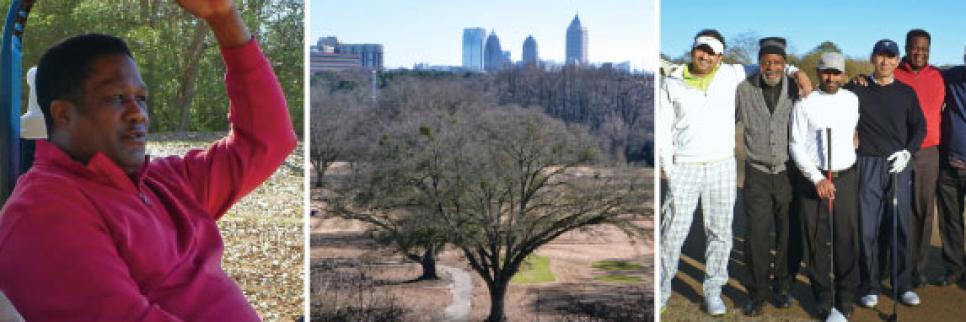Courses
The Battle For Atlanta

LEFT TO RIGHT: King Simmons; view of city from Bobby Jones; Pree Amin, Matt Adams, Sunny Singh, Jason Lee, Simmons and David Owen.
The 1948 U.S. Amateur Public Links Championship was played at North Fulton Golf Course
, in Atlanta's Chastain Memorial Park. Bobby Jones spoke at a pre-tournament dinner, and warned the competitors: "Never give a six-inch putt on Bermuda greens." A newspaper described the field as "minor Hollywood movie stars, gas station workers, glass blowers, bowling alley operators, caddies, greens keepers, welders, steel mill workers, truck drivers, mechanics, policemen and whatnots." The winning whatnot was a bartender from Long Beach, Calif., and the runner-up was an accountant from Portland, Ore. They ate breakfast together on the morning of their 36-hole final, and they finished their first round in two hours and 40 minutes and their second in two hours and 45.
The winner of the 1948 Publinx wasn't invited to play in the Masters—Augusta National added that qualification in 1989—but, if he had been, he would have been well prepared: North Fulton was a test. It hosted a tour event, the Atlanta Open, in the fall of 1947 (won by Tony Penna), and another, the North Fulton Open, the week after the 1950 Masters (both were won by Jimmy Demaret).
I played it on Martin Luther King Jr. Day, in a large group that included King Simmons, the general manager, who was a defensive back for Texas Tech, the Cleveland Browns and the San Diego Chargers; Jason Lee, who runs a diner where golfers often gather for pre-round eggs and grits; Sunny Singh, who owns liquor stores; and George Tasioudis, who is in the heating-and-air-conditioning business. Tasioudis was born in Greece. He played semi-professional soccer until he broke a knee, didn't take up golf until he was 45, and got to scratch without taking a lesson. He played Georgia State students for quarters at Candler Park, a nine-hole muny, but felt bad about taking their money and began inviting them to his house for dinner. Those meals evolved into weekly spaghetti parties, whose guests in 1996 included an assortment of Olympic athletes. Chris Kane, who has been Tasioudis' partner for 13 years (they met when she was working as a waitress in a Waffle House), told me, "George has a practice area in the attic, and after they ate they'd all go up there and hit balls and putt until 1 or 2 in the morning."
Tasioudis holds the course record—63—at Bobby Jones Golf Course
, in Atlanta Memorial Park, five miles away. Jones himself played a round at Bobby Jones on Dec. 30 in 1933, the year it opened; his foursome included Charles Yates, who, four months later, was the low amateur in the first Masters. (Jones and Yates played matches for what they called a "willy rock": a dollar bill.) The course added a clubhouse in 1941, and Jones returned for the dedication. Above the lintels on the front door and two of the front windows are bas-reliefs of angry raptors flanking what looks like the golf bag of Agamemnon.
The greens at Bobby Jones were redone in 2006 (with Champion Bermuda); they were the truest and fastest greens I putted on during my visit to Atlanta, which included rounds at two private clubs. But other parts of the course have suffered from hard use, long neglect and way too many trees. Bob Cupp, in conjunction with a group called the Atlanta Memorial Park Conservancy, has donated architectural plans for two possible redesigns: one for a shortened 18-hole course, and one for a "reversible" nine-hole course that would be playable in either direction (though not at the same time) and would leave room for a driving range. Cupp, who is in his 70s, told me that the only item on his bucket list, to the extent that he has one, is improving public golf in his hometown.
Not everyone shares Cupp's enthusiasm for his ideas. The main criticism I heard from Bobby Jones regulars, including members of a group called Friends of Bobby Jones Golf Course, is that the conservancy consists almost entirely of people who are not Bobby Jones regulars. The nine-hole configuration, which Cupp strongly prefers, is ingenious—Cupp told me he thinks it would attract national attention—but the people I played with said they hated the prospect of losing nine holes in a city that's already underserved. They view the conservancy's master plan for Memorial Park as something like eminent domain in reverse, and they characterized its backers to me as wealthy neighbors who, if they play golf at all, don't play it on city-owned courses. "This would be their little practice area during the week," one said, "and then on the weekend they'd go play at their private club."
It's a lot more complicated than that, of course. But you don't have to rush to pick a side, because the whole thing is now in the hands of the politicians.